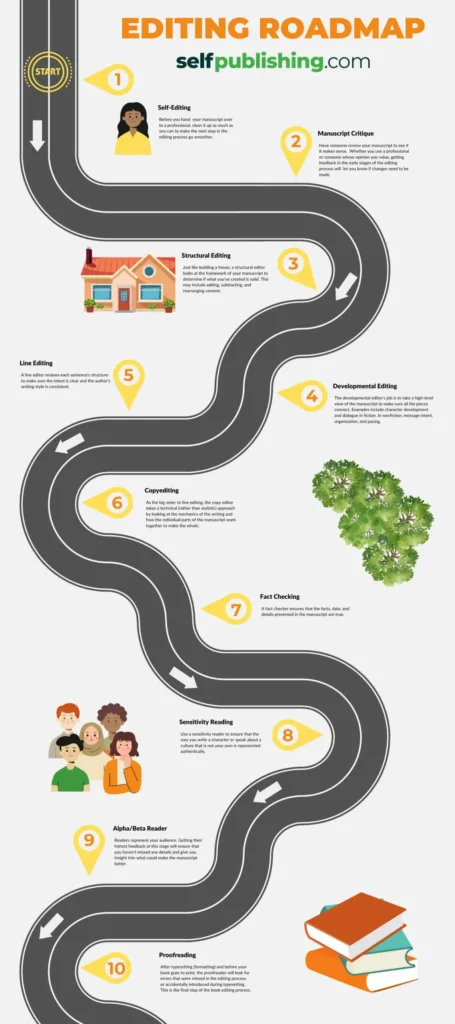Self-publishing continues to gain popularity as more authors discover its benefits; however, the competition can be stiff, and the learning curve is steep. Having a plan in place (you can work with a book coach to create one!) and using all the helpful tools available to authors makes the process of publishing a book less intimidating. So let’s start at the beginning: how to write your rough draft with a manuscript template.
There are many moving parts when preparing your manuscript for publication and no single one should be overlooked. Each step is designed to produce a professional and engaging book.
Use this guide and pre-formatted book template to take your manuscript from its raw state at the beginning of the process to a professionally edited and formatted book or novel that’s ready to be published.
Don’t make your bed hard – use a manuscript template!
Think about your favorite book. Was the message or story easy to follow? Did the content flow smoothly from chapter to chapter? Did you have a hard time putting the book down or find yourself going back to it again and again?
The ease with which you were able to connect to the words on the page is not a coincidence. When a book is well-written, professionally edited, and properly formatted, the reading experience is unencumbered. All of the pieces blend together seamlessly in the background so that the part that matters—the content—shines!
Having a great story or message is great and should be the focus of your writing process. But a proven manuscript template will help make sure that story gets read!
It will also make your work as an author so much easier.
If you’ve ever heard the saying “You’ve made your bed, now lie in it.” you likely understand the sentiment. Sometimes we make things unnecessarily difficult when there’s a better way. This applies to manuscript templates and book editing.
At some point, your manuscript will have to go from your word processor into the hands of an editor, designer, alpha reader, proofreader, and/or formatting software. Before it leaves your sight, you want to make sure that whoever (or whatever) gets it next can process it easily. Using a great manuscript and book template can also help decrease the cost of publishing your book as well!
For editors, you’ll want enough space between the lines to read their comments easily.
For interior book designers, the manuscript should be clean and error-free so that formatting will be easier. For early readers (called beta readers and alpha readers), fonts should be easy to read with ample margins and spacing between lines to help prevent eye fatigue.
Don’t re-create the wheel. Use the experience of the professional editors and already-published authors to make this part of your writing journey easier.
Our professional editors’ manuscript template guidelines
Here at selfpublishing.com, we see thousands of manuscripts every year – and our professional editing team knows exactly what it takes to turn a rough draft into a publish-worthy book or novel.
The following are pointers for formatting your manuscript. Some can be set up in your document or book writing software before you begin and apply to both fiction novels and nonfiction books.
- 8.5” x 11” or A4 standard paper size
- 12-point font (comfortable to most eyes)
- All lines should be double-spaced and the first line of each paragraph indented
- Times New Roman (or similar easy-to-read serif typeface)
- One-inch margins on all sides of the page
- Left-aligned
- Single space after periods
Doing these simple things will be especially useful when printing portions of a book for review or sending it to publishers for their consideration!
If you haven’t yet, download your manuscript template here:
How to prepare your manuscript for formatting
When getting your manuscript ready for formatting, you want to ensure that it’s easy to process by the production team. Follow these simple guidelines to avoid common formatting headaches later.
- Save in one of the following popular formats: DOC, DOCX, RTF, ODT, and Pages.
- Eliminate “extras” in your manuscript (hard returns, page numbers, and headers)
- Make sure images are high resolution (300 dpi or higher)
- Create a single file. Merge multiple files into one.
- Make sure all of the front matter and back matter is included:
- Front Matter
- Copyright Page
- Dedication Page
- Lead Magnet Page (optional)
- Table of Contents
- Acknowledgments Page (can include in the front matter or back matter)
- Preface
- Introduction
- Back Matter
- Author Page (fiction and nonfiction)
- Note from the Author (fiction and nonfiction)
- Bibliography (nonfiction)
- Endnotes (nonfiction)
- Index (nonfiction)
- Glossary (fiction and nonfiction)
- Front Matter
Related:
- Book Outline: How to Outline a Book in 6 Simple Steps
- How to Format a Book: 11 Book Formatting Tips in 2024
Manuscript formatting option 1: Use software
Both free and paid book formatting software is convenient and often easy to use. It’s also cost-effective when you’re working with a limited publishing budget. Keep in mind that automated formatting software has limitations and some professional formatting software has a steep learning curve.
If you’d like to try formatting software, here’s a short list to get you started (links to our reviews of each are included):
- Atticus: $147 one-time payment
- Chapterly: $9.99 – $14.99 per month
- Vellum: $199.99 – $249.99 one-time payment
- Affinity Publisher: $69.99 one-time payment
- Adobe InDesign: $22.99 per month
Manuscript formatting option 2: Hire a professional
Just like editors, interior book designers have more than a surface-level understanding of how to make the inside of your book look amazing.
If you have it in your budget, hiring a professional book formatter can make the difference between a book that looks okay or nice and one that is completely polished and customized with all of the extra to make your book stand out from the competition.
How to edit your manuscript and make it sing
The secret sauce of a great book is fantastic editing.
Now, we won’t get into all the different types of book editing here – just know that our editing services include a minimum of five(!!) book editing rounds. And that doesn’t include manuscript formatting or other production steps.
Here’s a quick roadmap to familiarize yourself with what’s in store for your manuscript:

Remember that the best books are a collaboration of book professionals with specific expertise.
You, the author create the story.
Book editors can take a manuscript and tweak, mold, chop, or lightly brush each word to ensure maximum impact. You may be an expert in your industry or a phenomenal storyteller, but the best editors understand structure, flow, pacing, grammar, syntax, and spelling, not to mention genre expectations. Manuscript template or not, it is their job to see your vision and keep moving your rough draft in the right direction.
Important note: Whether you hire a book editor or go with a service like ours, make sure you do each type of editing in order. They build on one another. Having to backtrack later because you missed a step will waste time and money, likely causing frustration as your book gets tied up in the process.
Want to give your editors a more polished rough draft? Use our free tool to improve your writing skills!
Key areas to focus on for a better reading experience
What the inside of your book looks like is just as important as the outside.
If your book typeface is strange, the spacing odd or nonexistent, and margins super tiny, your reader might make it to the Table of Contents, but it’s unlikely they’ll go much further. By using the manuscript template we share below, you can ensure you have the right formatting for a great reading experience.
Book formatting is the “art” of designing words on a page so that the reader has an enjoyable reading experience. It’s so important that we include it in nearly all of our book publishing programs. Professional book or novel formatting includes:
- Adequate spacing between lines: leading
- Adequate spacing between characters: kerning
- Sizeable margins
- Headers and footers
- Justified text
- Opening chapter treatments
- Added design elements that enhance the reader’s experience
Final tips for saving time and money with book production
As you prepare your manuscript template for the next stage of book production, here are a few more things to keep in mind.
- Giving proper attribution matters. If you quote someone else in your work or use excerpts, use footnotes and endnotes. Links are not enough.
- Children’s picture books are formatted differently than standard books. Learn the differences before you format yours.
- After your book is formatted, don’t forget to have it proofread before it goes to print. This will help you catch any mistakes that occurred during the editing process or formatting.
Book production can be intense, but with free tools like a pre-formatted template, a solid strategy in place, and maybe even a production team to support you (let’s talk if you’re interested in that!), getting your book ready for publishing can be a smooth – and even speedy – process. Securing the best team and resources for your budget will give you the best shot at creating a professional book that stands out in a crowded market.
If you take one thing from this post, let it be this: starting with a properly formatted manuscript template can keep things moving forward efficiently as your book moves through each stage of production.




